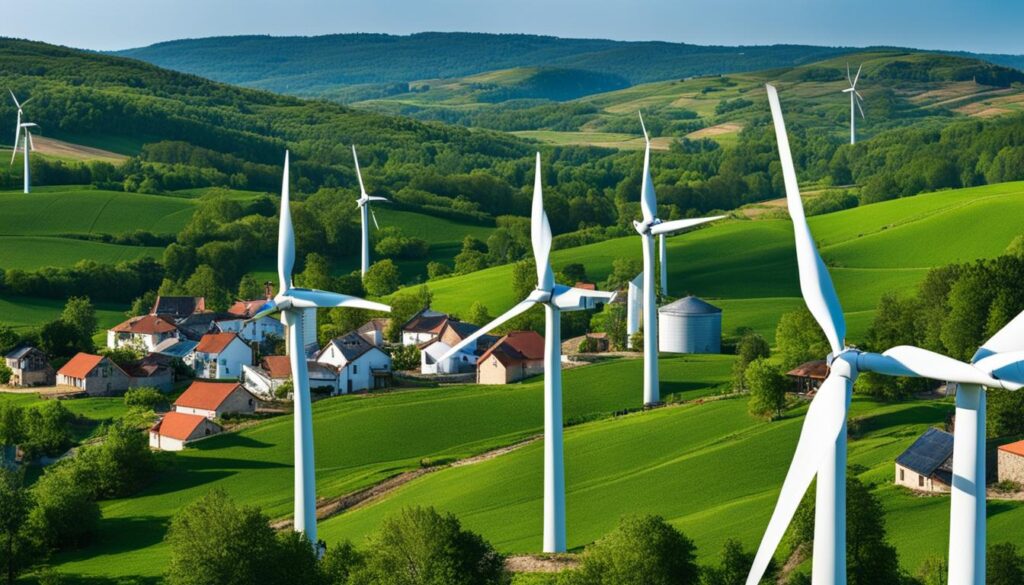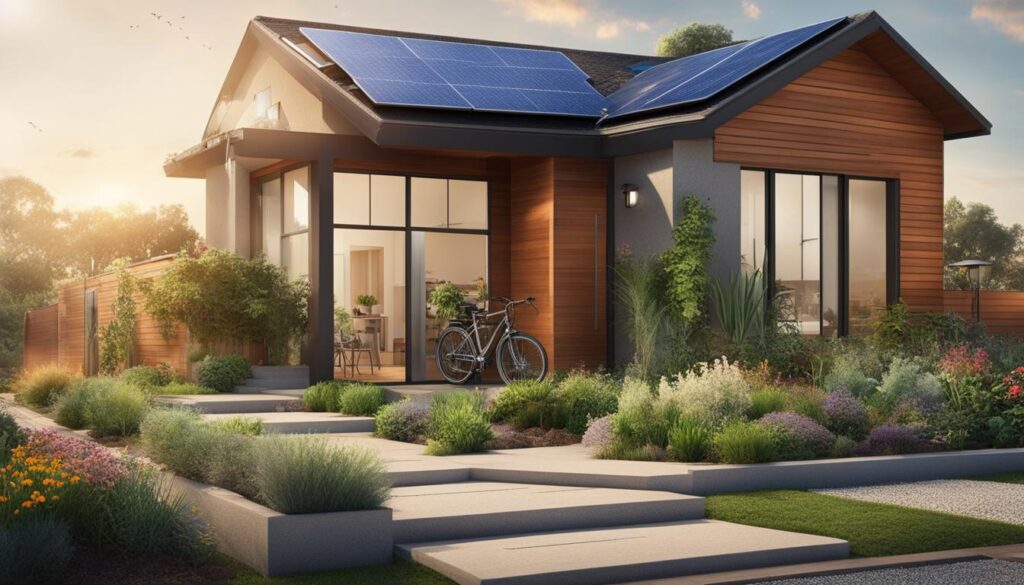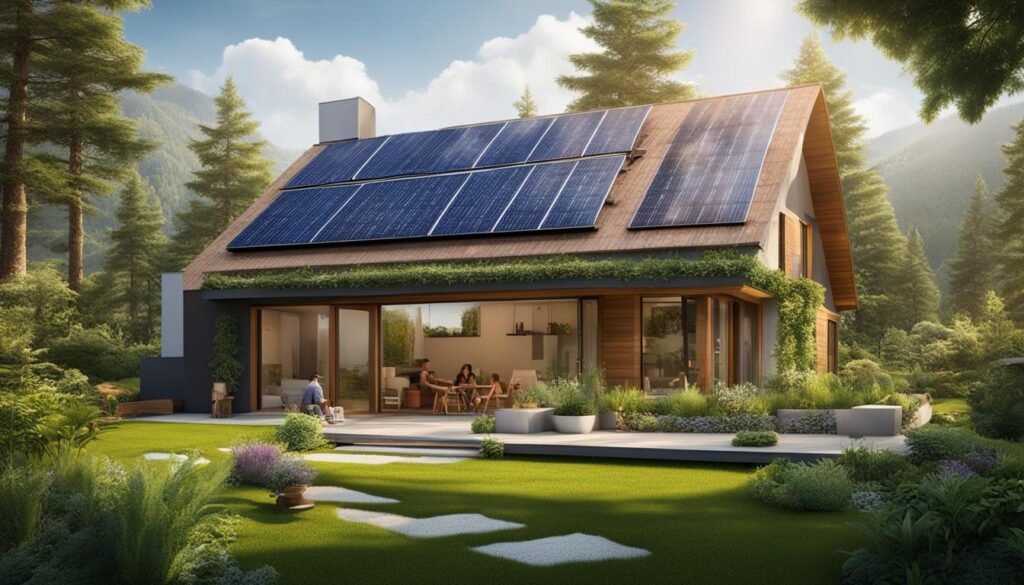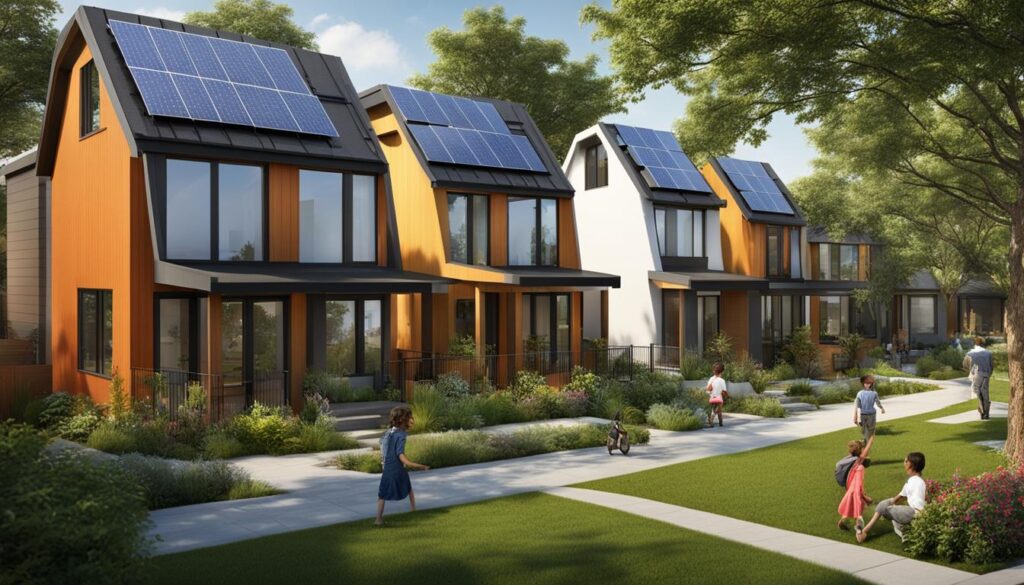Welcome to our primer on sustainable design, specifically tailored to Victorians looking to create eco-friendly homes. As we become increasingly aware of the impact our actions have on the environment, more and more people are seeking ways to reduce their carbon footprint and live sustainably. Sustainable design offers a practical and effective way to achieve this goal, allowing us to create beautiful and functional homes while minimizing our impact on the planet.
In this section, we will provide an overview of the basic principles of sustainable design and offer tips and strategies for incorporating eco-friendly practices into your home and lifestyle. Whether you are looking to build a new home or transform your current living space, this primer will help you get started on the path towards sustainability.
Key Takeaways
- Sustainable design enables us to create beautiful and functional homes while minimizing our impact on the environment.
- This primer provides an overview of sustainable design principles specifically tailored to Victorians.
- By incorporating eco-friendly practices, we can reduce our carbon footprint and contribute to a greener, more sustainable future.
- Whether you are building a new home or renovating your current living space, there are many practical strategies for creating an eco-friendly home.
- Water conservation, renewable energy, and sustainable materials are key components of sustainable design.
Understanding Sustainable Design
At its core, sustainable design seeks to create living environments that minimize negative impacts on the environment while enhancing the wellbeing of occupants. In this section, we will delve into the various components of sustainable design and explore how they can be applied to Victorian architecture and living spaces.
The Importance of Green Design Principles
Green design principles are central to sustainable design. By minimizing energy consumption, reducing waste, and utilizing eco-friendly materials, green design reduces the environmental impact of buildings and improves their overall sustainability. Such principles can be applied to all aspects of building design and construction, from insulation to lighting and ventilation.
Application to Victorian Sustainable Design
Victorian architecture presents unique challenges and opportunities for sustainable design. At the same time, Victorian homes present several opportunities to employ sustainable design principles in their preservation and updates. Considering the specific requirements of Victorian homes, architects and designers can use materials like reclaimed timber to add a modern touch and improve sustainability. At the same time, modern insulation can be used to minimize energy consumption while increasing comfort levels during the coldest days of the year.
“Sustainable design is not just about building eco-friendly structures, but about creating living spaces that positively impact the environment and the people who inhabit them.”
Benefits of Sustainable Design
Sustainable design presents several benefits, from increased energy efficiency and cost savings, to enhanced comfort, and improved air and water quality. It also leads to the creation of healthier, more enjoyable living spaces. Building a home with green design principles in mind means that the building will continue to contribute to environmental preservation and human well-being for years to come.
Creating Eco-Friendly Homes
At the heart of sustainable living is the home. By adopting eco-friendly practices, we can reduce our impact on the environment, save money, and create healthy, sustainable homes that protect our health and well-being. Here are some tips and strategies for creating eco-friendly homes in Victoria:
Energy-Efficient Appliances
Investing in energy-efficient appliances is a simple and effective way to reduce your home’s energy consumption. Look for appliances with the Energy Star rating, which indicates they meet energy efficiency standards. When shopping for appliances, consider their energy consumption and choose models with the lowest wattage possible. Opt for a gas stove instead of an electric one, and use a microwave or toaster oven for small meals instead of heating a large oven.
Sustainable Building Materials
When building or renovating your home, choose sustainable building materials that minimize environmental impact. Look for materials made from renewable resources, such as bamboo flooring or cork insulation, or those with recycled content, such as reclaimed wood. Avoid materials that contain toxic chemicals or heavy metals and opt for low-VOC paints and sealants.
Design for Sustainability
Innovative design techniques can go a long way in promoting sustainability in the home. Consider incorporating passive heating and cooling strategies, such as large windows and natural ventilation, to reduce energy consumption. Use shading devices to block direct sunlight during the summer, and choose window treatments that allow sunlight to enter during the winter. Consider installing skylights to bring natural light into the home and reduce the need for artificial lighting.
| Sustainable Design Strategy | Benefits |
|---|---|
| Passive solar heating | Reduces energy consumption and saves money on heating costs. |
| Green roofs | Reduces stormwater runoff and improves air quality, while providing insulation and a habitat for wildlife. |
| Xeriscaping | Reduces water consumption and maintenance costs by using drought-tolerant plants. |
Incorporating Renewable Energy
Renewable energy sources such as solar power and wind energy offer exciting opportunities for Victorian homeowners to embrace sustainable living practices. By incorporating these alternative energy sources into our homes, we can reduce our carbon footprint and contribute to a greener future.
Solar Panels

Solar panels convert sunlight into electricity and can be installed on rooftops or in gardens. By using solar energy to power our homes, we can reduce our reliance on non-renewable sources and save money on electricity bills. It’s worth noting that solar panels require a significant upfront investment, but the long-term benefits make them a worthwhile addition to any sustainable home.
Wind Turbines
Wind energy can also be harnessed to power our homes. Small wind turbines can be installed in gardens or on rooftops and generate electricity as long as there is a consistent wind source. While wind turbines are less popular in Victoria than solar panels, they are still a viable option for those looking to incorporate renewable energy sources.
Alternative Energy Solutions
In addition to solar panels and wind turbines, there are other alternative energy solutions worth exploring. For example, some homes may be suitable for geothermal heat pumps, which use the earth’s natural temperature to regulate indoor heating and cooling. Another option is bioenergy, which involves using organic materials such as wood chips to generate energy. Exploring different renewable energy sources can help us find the best fit for our homes and lifestyles.
Managing Water Consumption
Water is an essential resource, but it’s also a precious one. By implementing eco-friendly practices, we can reduce our water consumption and help preserve this valuable resource. In this section, we will share with you some tips and techniques to manage water consumption in Victorian homes, ensuring sustainable living practices that align with Victorian sustainable design.
Rainwater Harvesting
Installing a rainwater harvesting system is an eco-friendly way to collect rainwater that can be used for various purposes such as watering your garden, washing cars, or flushing toilets. It’s a great way to reduce your water consumption and make better use of this valuable resource. If you’re considering installing a rainwater harvesting system, make sure you choose the appropriate tank size for your needs and position it to receive the maximum rainfall. Don’t forget to check with your local council authorities to know the regulations about rainwater tanks.
Greywater Systems
A greywater system allows you to reuse water from sources such as your washing machine, shower, sink, or bath. The wastewater is treated and redistributed to your garden or lawn, reducing your water consumption and minimizing water going to the wastewater treatment plant. When planning to install a greywater system, ensure that you choose a suitable system that fits your budget, location, and water use needs. And it always a good idea to contact your local council authorities about the regulations and guidelines on greywater systems in your area.
Efficient Plumbing Fixtures
Installing water-efficient plumbing fixtures in your home can help reduce water consumption significantly. Look for showerheads, faucets, and toilets with the Water Efficiency Labeling and Standards (WELS) certification. This label rates products based on their water efficiency and gives a star rating from 1 to 6, with 6 being the most water-efficient. By choosing and installing products with a higher rating, you can significantly reduce your water consumption and also save money on water bills. Also check with your local council authorities for incentives provided for water-efficient plumbing fixtures.
Sustainable Landscaping

Landscaping is an essential component of sustainable living, enhancing the aesthetic value of a home and promoting environmental preservation. At our company, we recognize the importance of eco-friendly practices when it comes to designing a landscape that aligns with Victorian sustainable design principles. Our team of experts can help you create a garden that not only looks beautiful but is also sustainable.
We recommend a variety of sustainable gardening techniques such as composting, mulching, and companion planting. These techniques help to reduce waste, improve soil quality, and promote plant growth while minimizing the use of chemicals and reducing water consumption.
Native plant selection is another important aspect of sustainable landscaping. Native plants are well-adapted to the local climate and require less maintenance, making them ideal for eco-friendly practices. At our company, we can help you identify native species that are suitable for your region and incorporate them into your garden design.
“Sustainability is the foundation of our business. We believe in promoting eco-friendly practices that benefit the environment while enhancing the beauty and functionality of your landscape.”
We also recommend incorporating a water-wise irrigation system that utilizes rainwater harvesting and greywater systems to minimize water consumption. Our team can guide you in selecting irrigation systems that are best suited to your garden’s needs.
Finally, we promote the use of sustainable materials and furnishings for outdoor spaces. We recommend using reclaimed wood, recycled materials, and low VOC products for decking, seating, and other elements. By using these sustainable outdoor materials, you can reduce your environmental impact while enjoying a beautiful and eco-friendly outdoor space.
Sustainable Materials and Furnishings
Choosing the right materials and furnishings is key to achieving a sustainable home that aligns with Victorian sustainable design principles. Opting for eco-friendly and sustainable materials not only minimizes the negative impact on the environment but also enhances the overall aesthetic and comfort of your home. Here are some sustainable materials and furnishings to consider:
Reclaimed Wood
Reclaimed wood is an eco-friendly alternative to traditional new wood products as it repurposes previously used wood. This reduces the carbon footprint of your home and supports sustainable forestry management. Reclaimed wood furniture, flooring, and decorative accents add rustic charm and warmth to any Victorian home.
Recycled Materials
Recycled materials such as glass, aluminium, and plastic can be transformed into stylish and durable home accessories. Look for products made from post-consumer recycled materials such as rugs, throw pillows, or lampshades to minimize waste and support a circular economy.
Low VOC Products
The use of high VOC (volatile organic compound) products such as paint, adhesives, and cleaning products can contribute to indoor air pollution and negatively affect our health. Choosing low VOC products will ensure better air quality and a healthier living environment for you and your family. Look for products that are labelled as zero or low VOC.
“Sustainability is not about being perfect. It is about doing better, little by little, every day.”
By incorporating sustainable materials and furnishings, Victorian homeowners can contribute to a more sustainable future for the environment and their communities. Start small by swapping out one item at a time, and before long, you’ll have a beautiful and sustainable home that you can be proud of.
Energy-Efficient Heating and Cooling
In Victorian homes, heating and cooling can contribute to a significant portion of energy consumption. However, by implementing smart solutions, you can reduce your impact on the environment and your energy bills. In this section, we will explore several energy-efficient heating and cooling options that promote sustainable living.
Insulation and Weatherization
A well-insulated home will maintain a consistent temperature, reducing the need for constant heating and cooling. By adding insulation to your walls, floors, and attic, you can create a more energy-efficient living space. Proper weatherization, such as sealing drafts and upgrading windows, can also significantly improve your home’s insulation, keeping it more comfortable year-round.
Passive Design Techniques
Passive design techniques utilize natural features of your home to regulate temperature, reducing the need for energy-intensive heating and cooling systems. For example, clever placement of windows can allow for greater natural light and air circulation, minimizing the need for artificial lighting and air conditioning.
Smart Thermostats
Smart thermostats are the perfect complement to energy-efficient homes. By enabling you to control temperature settings remotely and automatically, they can reduce energy waste and lower your bills. Many models also provide detailed insights into your energy consumption, so you can make more informed decisions about your energy usage.
Incorporating energy-efficient heating and cooling can have a significant impact on your home’s sustainability. By using these techniques, you can create a more comfortable living space while reducing your environmental footprint.

Building a Sustainable Community
A sustainable future relies not just on individuals, but on cohesive communities working together for a common cause. As part of our guide to Victorian sustainable design, we want to highlight ways in which local residents can band together to make a meaningful impact. Here are some actionable tips for creating a sustainable community in Victoria:
Support Local Businesses
One of the best ways to promote sustainability is by supporting local businesses whenever possible. This helps reduce transport emissions and encourages the circulation of resources within the community. Whether it’s visiting farmers’ markets or choosing a locally owned boutique, there are plenty of ways to support small businesses and contribute to a greener Victoria.
Participate in Community Initiatives
Victoria is home to a range of community groups that are dedicated to promoting sustainability and eco-friendliness. By participating in initiatives led by these groups, such as beach cleanups or tree planting events, you can make a tangible contribution to the local environment. Not only that, but you’ll meet other like-minded individuals and develop a sense of connection to your community.
Organize Shared Resources
Sharing is a great way to reduce consumption and promote sustainability. Consider organizing a carpooling scheme in your local area or creating a tool-sharing program for residents. The possibilities are endless, and by working together, you’ll be able to reduce your environmental footprint while building stronger bonds within your community.
Advocate for Change
Finally, don’t be afraid to speak up and advocate for change in your community. Whether it’s pushing for more bike lanes or advocating for greener building codes, your voice can make a difference. By working with local councils and businesses, you can help create a more sustainable future for Victoria.
“A sustainable community is one that is built on a sense of shared purpose, a commitment to preserving the environment, and a desire to ensure a bright future for generations to come.” – Green Victoria Initiative
Conclusion
At the end of the day, sustainable design is all about making conscious choices that have a positive impact on our environment. We hope that this primer has provided valuable insights into sustainable design principles and practices that are relevant to Victorians.
By incorporating eco-friendly practices and making sustainable choices, we can all play a role in creating a greener future for our homes and communities. Whether it’s by using energy-efficient appliances, choosing sustainable building materials, or engaging in community initiatives, every effort counts.
With this primer as your guide, we encourage you to explore the possibilities of sustainable design and find ways to incorporate it into your everyday life. By doing so, you can help build a more sustainable and resilient Victoria.
Thank you for joining us on this journey towards a more sustainable future.
Sustainability tips, sustainable design, and a primer for Victorians – we hope this article has been informative and useful. Stay tuned for more sustainability content from us in the future!
FAQ
What is sustainable design?
Sustainable design is an approach to creating homes and buildings that minimize negative environmental impacts by using eco-friendly practices and materials. It focuses on reducing energy consumption, promoting renewable energy, managing water resources, and creating healthy and efficient living spaces.
How can I incorporate sustainable design principles into my Victorian home?
There are several ways to incorporate sustainable design principles into your Victorian home. You can start by using energy-efficient appliances, insulating your home, and choosing sustainable building materials. Additionally, incorporating renewable energy sources like solar panels and managing water consumption can greatly contribute to sustainable living.
What are some eco-friendly practices I can adopt in my home?
There are many eco-friendly practices you can adopt in your home. Some examples include using energy-efficient light bulbs, recycling and composting, reducing water usage, and opting for natural cleaning products. You can also consider growing your own food, using sustainable materials in your furnishings, and minimizing waste through mindful consumption.
How can I make my Victorian home more energy-efficient?
Making your Victorian home more energy-efficient involves several steps. You can start by properly insulating your home to reduce heat loss in winter and heat gain in summer. Installing energy-efficient windows and doors, using smart thermostats, and opting for high-efficiency heating and cooling systems can also significantly reduce energy consumption.
What are some sustainable landscaping practices I can implement?
Sustainable landscaping practices include planting native species, minimizing water usage by using drought-tolerant plants, and using organic mulch to improve soil health. It’s also important to avoid using chemical pesticides or fertilizers and to create habitats for local wildlife. Rainwater harvesting and implementing efficient irrigation systems are other sustainable landscaping strategies.
How can I choose sustainable materials and furnishings for my Victorian home?
When choosing sustainable materials and furnishings, look for options such as reclaimed wood, recycled materials, and products with low VOC (volatile organic compound) emissions. You can also opt for furniture made from sustainable sources and choose fabrics and finishes that are eco-friendly and minimally processed.
How can I contribute to building a sustainable community?
To contribute to building a sustainable community, you can participate in local green initiatives, support local businesses that follow sustainable practices, and get involved in community gardens or composting programs. You can also educate your neighbors about sustainable living practices and advocate for sustainable policies at the local level.
What are the benefits of incorporating renewable energy sources into my Victorian home?
Incorporating renewable energy sources, such as solar panels, can significantly reduce your carbon footprint by generating clean and sustainable electricity. It can also help you save on energy costs over the long term and contribute to a more resilient and decentralized energy system.
What are some water conservation strategies I can implement in my Victorian home?
Some water conservation strategies include installing low-flow fixtures, collecting rainwater for outdoor use, and using greywater systems to recycle water from showers and laundry. Proper maintenance of plumbing systems to fix leaks and practicing water-efficient habits, such as taking shorter showers and turning off taps when not in use, can also contribute to water conservation.
How can I create a more sustainable and energy-efficient home through smart design choices?
Creating a more sustainable and energy-efficient home involves making smart design choices. You can maximize natural light and ventilation by incorporating large windows and proper window orientation. Using passive solar design techniques, such as shading devices and natural landscaping, can also reduce the need for artificial heating and cooling. Additionally, investing in energy-efficient appliances and technologies, such as smart thermostats and LED lighting, can further enhance energy efficiency in your home.
